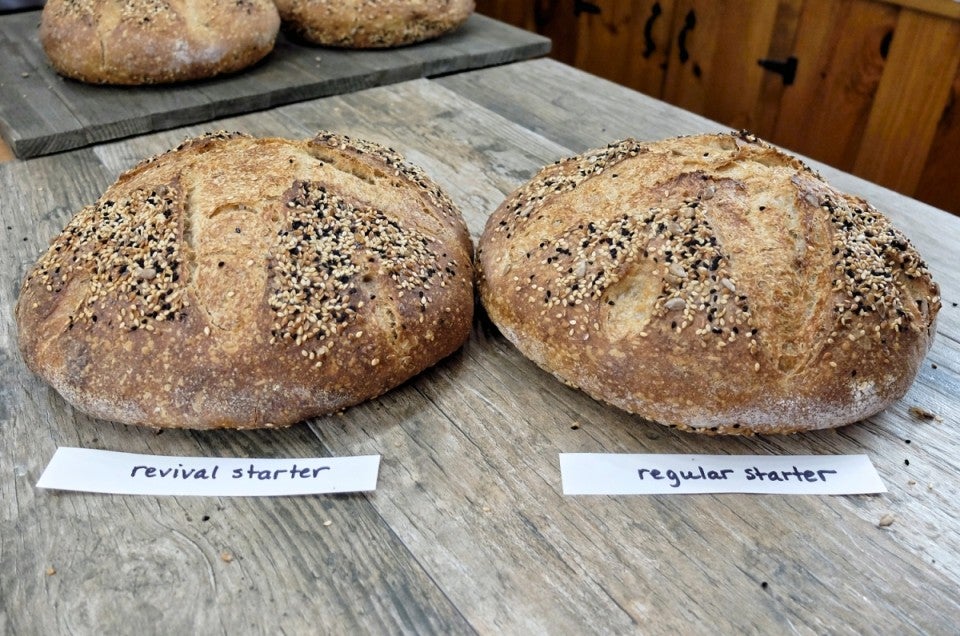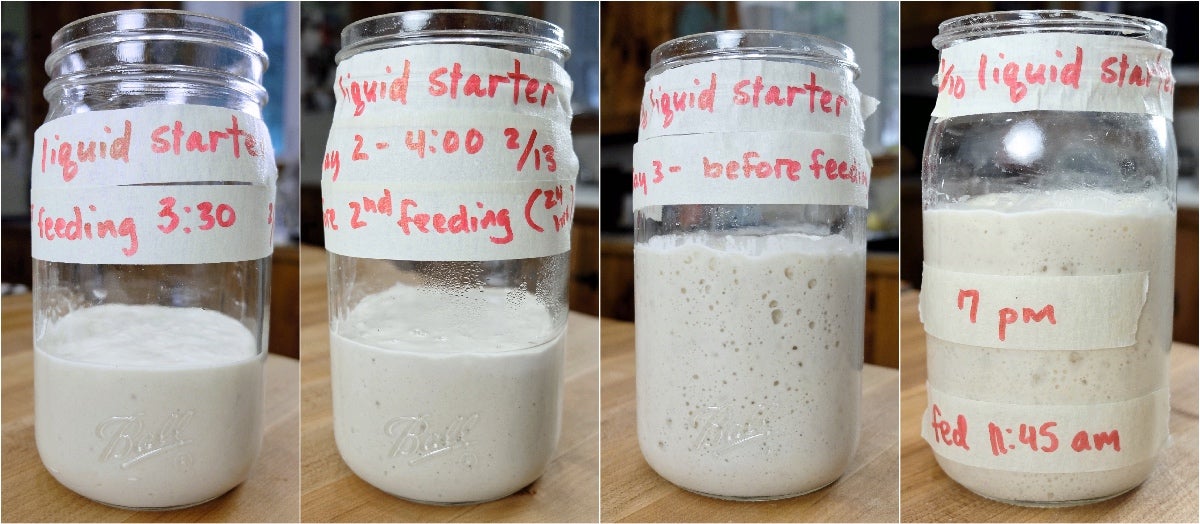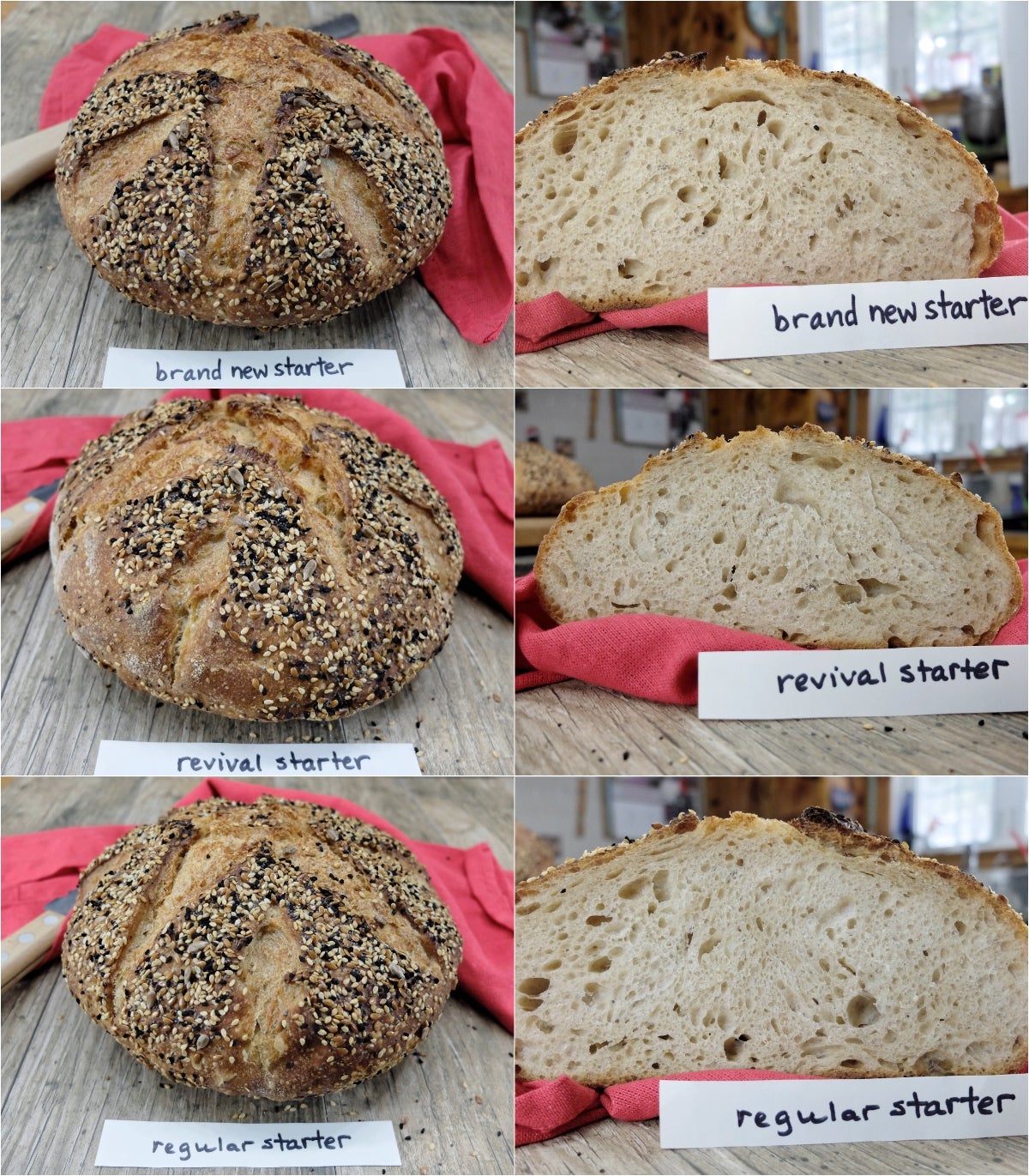


In our first sourdough starter troubleshooting post we tackled sourdough starter viability, and what will and won't cause your starter's demise. We also found out what a spoiled starter looks like, and how to know when it's time to throw it out and start over.
Today we'll take on the thorny question of whether it's worthwhile to try to revive an old but struggling starter — or if it's best to start over.
Creating your own starter from scratch is exciting and even a little magical; for details, see our step-by-step guide to creating a sourdough starter.
Simply mixing flour and water allows friendly bacteria and wild yeast to join forces and establish a balanced ecosystem that is able to impart great flavor and rise to your sourdough baking.

During the 6 to 10 days that it takes to get your starter up and running, it's a little more vulnerable to bacterial intruders and mold because it hasn't yet developed the defenses of a mature starter. But once fully developed, a well-maintained starter will readily fend off unwanted invaders and is very unlikely to spoil.
What if you inherited an old starter from your grandma and it's looking a little like it might be at death's door?

Sourdough authorities argue that there's nothing sacred about an old starter; a freshly developed "mature" starter will impart just as much flavor and rise to your bread.
Starting over with a new starter will get you back to baking great sourdough bread in a little over a week. So why take on the unpredictable task of trying to resurrect a sickly starter?
And is it even possible to thoroughly revive a starter that's sorely neglected?
Let's find out.


I start with two very neglected starters. Both starters (one all-purpose, one whole wheat) had been well-maintained until they were left at room temperature for a full month without being fed.
Why test both a white and a whole wheat starter? Starters can be maintained with all different types of flour, so I wanted to see if a whole wheat starter responded in the same way as a starter fed with all-purpose flour.


I pour the dark hooch off the neglected starters, and feed them following the feeding schedule called for in our sourdough starter recipe.
The revived starters smell a little "off" at first, but not awful; think vinegary sour, with a slightly unpleasant edge. Within four days they're rising well and have a nice, mildly tangy aroma. My theory is that both the acidity and the maturity of the neglected starters helps them fight off unwanted bacteria at the beginning of the process, which might allow for a faster return to a healthy and balanced starter.

By way of comparison, I also begin a starter from scratch. My brand-new starter is able to keep up in terms of rise. However, after four days it still smells a little funky and doesn't seem quite ready for baking bread.
On Day 4 (after only four feedings) I bake Naturally Leavened Sourdough Bread using my revived starters (which I mix together for the test), and my regularly well-maintained starters.


The results are a little shocking: two beautiful and delicious loaves. Both loaves taste mildly sour, although taste testers agree that the revived-starter loaf is slightly tangier.
On Day 5, after a total of six feedings, I try another test bake—this time including the brand-new starter; the revived starters, and my well-maintained regular starter.

Again, the results are surprising: three nice loaves, each with a similar rise and crumb structure. The only real difference is in the flavor of the breads. Each has mildly sour flavor, but the brand-new starter yields a slightly blander loaf.
It's definitely worth trying to revive a neglected starter (so long as it shows no signs of contamination). Pour off any discolored hooch, and start feeding it twice a day at room temperature. If it rises well and has a good aroma after three to four days, you're back in business!
We'd love to hear your own sourdough starter stories and questions below. Did you revive your starter from the brink of death? How long did it take? Is it thriving now?
For more information, please check out our first sourdough starter troubleshooting post.


May 9, 2020 at 11:43pm
I accidently fed the mother both the 1 cup water n flour. Without taking half out n place in fridge. Now i have this on top of my fridge overnight. Am i able to take out 1 cup n put in fridge for my mother?
May 13, 2020 at 1:08pm
In reply to I accidently fed the mother… by Ak2020 (not verified)
Hi AK2020, I'm a little confused about your normal starter process and what you did incorrectly. Did you forget to discard? Normally, if you're following our sourdough starter recipe, a regular maintenance feeding involves discarding about 1 cup (8 ounces, 227g) of starter and feeding the remaining 1/2 cup (4 ounces, 113g) starter with 1/2 cup (4 ounces, 113g) water and 1 scant cup (4 ounces, 113g) flour. Did you forget to discard? The "mother" starter is the one you feed and maintain regularly, while the discard can be stored in the refrigerator and used for up to a week in recipes calling for discard. If what you stored up on top of your refrigerator was still just flour, water and starter (without any other added ingredients), then you can certainly get back on track with your feeding routine, and save some discard in the refrigerator. It won't cause any permanent harm to your starter if you accidentally forget to discard or add the wrong amount of flour or water—just return to the correct ratio of ingredients when it comes time for your next feeding. Once your mother starter is rising predictably, then you can give it one more feeding, let it sit out for 2-4 hours, and then store it in the refrigerator for up to a week. I hope this helps! Let us know how it goes.
Barb
May 7, 2020 at 11:24am
Have had difficulty getting my started active enough to bake a descent loaf. I grind my own flour and have been using a 50/50 combination of hard red and hard white to feed the starter. Is that ok or should I maintain my starter with AP flour? Also what mix of berries would you use to produce a good all purpose flour?
May 11, 2020 at 11:29am
In reply to Have had difficulty getting… by Angela Morrow (not verified)
Hi Angela, feeding your starter with part red wheat and part white wheat should work fine, although you may find that your whole wheat starter contributes a bit more sour flavor and not quite as vigorous a rise to your bread baking as compared to a starter maintained with AP flour. That's because wholegrains tend to promote more lactic acid bacteria (LAB), while AP flour generally leads to conditions that favor the wild yeast. This isn't written in stone, however, since lots of other factors affect the flavor and rise of your sourdough bread throughout the bread production process. I would be sure that your whole wheat starter is vigorous and healthy and is doubling in size predictably, and then try adding ripe starter to our Pain Au Levain recipe, which offers a stiff white flour levain to help boost the rise in your bread. I don't have much experience with milling my own flour, so I'm afraid I can't advise you on what type of wheat to use, other than hard red wheat is what we use for our AP flour. I hope this helps! Let us know how it goes.
Barb
May 7, 2020 at 10:57am
I just wanted to share my experience with reinvigorating an extremely neglected starter. I have a mature starter (more than 10 years old) that was sadly neglected -- it languished for more than a year, unfed, in my refrigerator! It looked and smelled okay so I decided to try and resurrect it. I didn't want to commit too much flour to this project as I was pretty sure that it was hopeless, so I started with a mere teaspoon of the starter (10 g) mixed with equal amounts of flour and water. I fed it once a day with flour and water equal to the amount of the starter. For the first 3 days, it didn't look like much was happening, then this morning it was full of bubbles and had risen to twice its starting volume. The real test will be when I try to bake something with it, but I think it will be okay. The original source for the starter was the one that I bought from KAF years ago -- this strain must be bulletproof!
May 10, 2020 at 8:53am
In reply to I just wanted to share my… by Vivian (not verified)
Hi Vivian, thanks for sharing this revival story! I hope your starter has continued to thrive, and you're currently baking some beautiful and delicious sourdough bread with it!
Barb
May 4, 2020 at 8:14pm
On DAY 2, I fed my starter and 5 hours later it had tripled in size and overflowed the jar. Should I feed as usual in a larger jar and then feed again morning of day 3? Not sure what to do.
May 11, 2020 at 9:28am
In reply to On DAY 2, I fed my starter… by Nini1 (not verified)
Hi Nini1, I'm sorry I wasn't able to respond to your question earlier! I realize you're well past this day 2 dilemma, and hope that you found a workable solution. If you need a more timely response you might consider calling our Baker's Hotline at 855-371-2253. We're here M-F from 9am-9pm EST, and on Saturday and Sunday from 9am-5pm EST. In general, your starter jar should be large enough to accommodate doubling, plus extra room for fermentation gases to collect above the starter. Most sourdough recipes also call for discarding a portion of the starter each time you feed it, which should keep the quantity of starter you're maintaining consistent. I doubt you'll see this type of tripling behavior again, as it sounds like it was due to a type of bacteria that gives off carbon dioxide, rather than wild yeast. This bacteria will get weeded out as your starter develops towards maturity. Often this type of early vigorous rise corresponds to a subsequent delay in rising, which can go on for several days. If you're experiencing a lull in rising, you might want to consider this alternative feeding routine, which is meant to lower the pH of the starter environment:
1. Feed only once a day.
2. Feed with whole wheat or whole rye flour, rather than AP.
3. Feed with a ratio by weight of 2 parts starter : 1 part water : 1 part wholegrain flour. For example, You could feeding 1/2 cup (4 ounces, 113g) starter with 1/4 cup (2 ounces, 57g) water and 1/2 cup (2 ounces, 57g) wholegrain flour.
Once your starter is rising predictably (twice) with this method, then you want to switch back to twice a day feedings, which will further promote the wild yeast. You may also want to gradually transition to AP flour and the 1:1:1 ratio of ingredients by weight, called for in our sourdough starter recipe.
You may notice some hesitation each time you change up your starter's feeding routine, as it takes time for the organisms to adjust to changes, but when your starter begins rising predictably again, then you can consider your starter mature.
I hope this helps! Let us know how it goes.
Barb
May 4, 2020 at 7:41pm
Hi. I'm on day 2 of my starter and I noticed some greenish streaks on the surface of my starter (no fuzz). A few hrs later later the streaks increased. I poured it off and fed my starter. Has it gone bad? It smells like vinegar and a bit unpleasant.
May 10, 2020 at 8:49am
In reply to Hi. I'm on day 2 of my… by Rachel (not verified)
Hi Rachel, I'm sorry I wasn't able to reply to your question more promptly! It sounds like what you may have seen was mold, which is usually an indication that it's time to start over. Sourdough starters during the creation process are particularly prone to mold because they haven't yet developed the natural defense mechanisms of a mature starter. And mold is naturally everywhere—in the air, and in the flour. Mixing water and flour and letting it sit out untouched for a few days is practially an invitation for mold. However, there are some things you can do to try to prevent mold from taking over your starter. The best defense is to avoid leaving it longer than 24 hours without feeding it (or at least stirring it), especially when it's very new. Mold needs oxygen, which is why it develops on the surface of the starter; stirring the starter will disrupt this growth by robbing it of oxygen. All that being said, if you continued to feed your starter and haven't seen any more greenish streaks, then I would proceed with confidence. In this case, you were likely able to flush it out and your starter is continuing to develop its natural defenses. Good luck and let us know how it goes!
Barb
Pagination